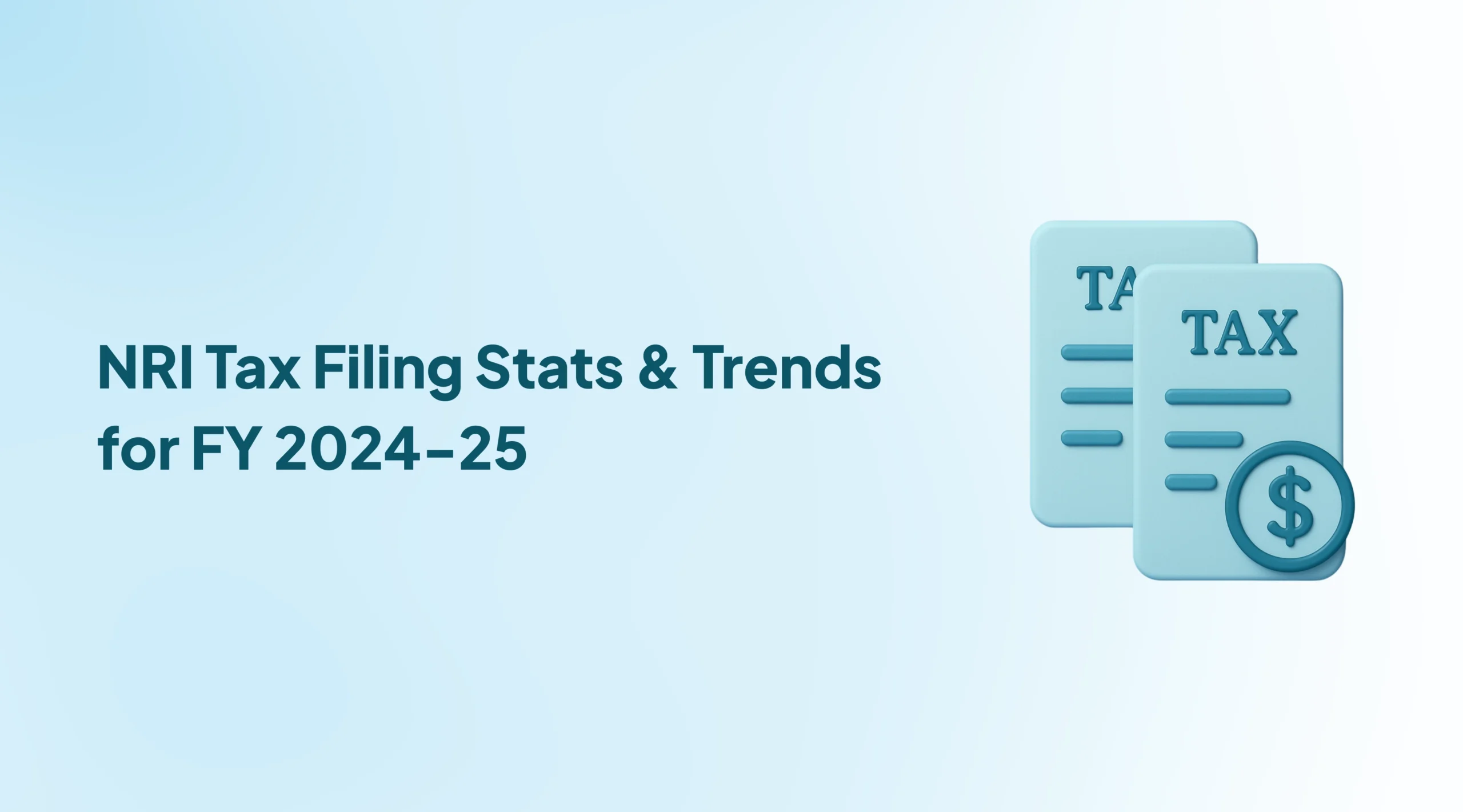The landscape for NRI tax filing is changing fast. The Indian government has tightened digital compliance. It has also expanded its AI powered scrutiny. This means the rules are clearer, but the margin for error is thinner than ever.
This article compiles the latest figures for FY 2024-25. We will look at how many NRIs filed returns, what triggered audits, and the most common mistakes that can lead to penalties. Our data comes from provisional CBDT releases and major NRI tax advisory platforms.
How Many NRIs Filed Income Tax Returns in FY 2024-25
The number of NRIs filing income tax returns in India is climbing steadily. It is not just about compliance anymore. It is about claiming refunds and managing financial footprints in a connected world.
Here is a quick look at the provisional data for the last three years.
| Financial Year | Provisional Number of NRI ITRs Filed | Year-on-Year Growth |
|---|---|---|
| FY 2022-23 | ~9.8 Lakhs | Baseline |
| FY 2023-24 | ~11.2 Lakhs | ~14% |
| FY 2024-25 | ~12.9 Lakhs (Estimated) | ~15% |
Preliminary CBDT data indicates a 15 percent rise in NRI ITR filings. This growth is led by UAE based filers, followed closely by NRIs in North America.
Think of it like a neighborhood watch, but for financial data. The government is getting better at seeing who owns which house. More people are realizing it is better to be on the list.
The regional breakdown tells its own story. NRIs in the Gulf region, especially the UAE, show the highest growth. This is likely due to increased awareness and higher remittances. North America based NRIs, while filing in strong numbers, also show a higher rate of audit triggers. Their complex financial situations often involve dual reporting under the DTAA.
So, when you ask “how many NRIs filed income tax returns in India 2024-25?”, the answer is a record number. The trend is clear. Compliance is becoming the norm, not the exception.
Emerging Audit & Scrutiny Trends for NRIs
The days of manual scrutiny are fading. The CBDT now uses an AI driven risk assessment model. This system automatically flags returns that look unusual. It is like a very smart, very diligent security scanner at the airport. It does not stop everyone. But it flags the bags that need a second look.
For NRIs, certain actions almost guarantee a flag.
What Triggers an Audit for NRI Returns
Based on the latest patterns, here are the top triggers for an NRI tax audit.
- AIS and Form 26AS Mismatch. This is the biggest trigger. The Annual Information Statement (AIS) is now incredibly detailed. It shows your bank interest, stock market transactions, and foreign remittances. If the income you declare does not match the AIS, the system notices instantly.
- Omission of Foreign Assets. Failing to fill out Schedule FA for foreign assets and income is a major red flag. The government receives this data automatically through FATCA and CRS agreements.
- Large Capital Gains without Reinvestment Proof. Reporting capital gains over 50 lakh rupees from property sale, without showing proof of reinvestment under Section 54 or 54F, will attract attention.
- Unverified DTAA Claims. If you claim tax relief under a Double Taxation Avoidance Agreement (DTAA) but forget to file Form 67, your claim will be rejected. This often leads to a demand notice and further scrutiny.
- Frequent High Value Remittances. Sending money to India under the Liberalised Remittance Scheme (LRS) is common. But frequent remittances exceeding 25 lakh rupees in a year, especially if the source is unclear, can prompt questions.
In FY 2024 25, about 4.1 percent of NRI ITRs were flagged for review. Most were for asset mismatch or high value capital gains.
The authority behind this increased scrutiny is simple. FATCA and CRS data sharing programs are now mature. They give the Indian tax department a clear window into your overseas financial accounts. Trying to hide income is like trying to hide a car in a parking lot when the authorities have your license plate number.
Top NRI Tax Return Error Patterns & Compliance Gaps
Many NRI tax notices are not about fraud. They are about simple, avoidable mistakes. I recently reviewed a case for an NRI client in Singapore. He was confident his return was perfect. But he had used the wrong ITR form. That one error cost him a penalty and months of correspondence.
Here are the most frequent filing errors we see.
- Incorrect Residential Status. This is the foundation of your tax liability. Getting it wrong means you are taxed as a resident. This subjects your global income to Indian tax. The rules in Section 6 of the Income Tax Act are specific. You must apply them correctly.
- Choosing the Wrong ITR Form. Many NRIs with complex incomes still file ITR-1. If you have capital gains, foreign assets, or are a director in a company, you likely need ITR-2 or ITR-3. Using the wrong form is an instant rejection.
- Missing Disclosure of Overseas Assets. Even if an asset does not generate income, it must be disclosed in Schedule FA. This includes foreign bank accounts, mutual funds, and insurance policies.
- Ignoring Capital Gains from Mutual Funds. Selling Indian mutual funds while living abroad still creates a tax event in India. Many NRIs forget to report this, leading to a mismatch with the AIS.
- TDS Mismatch on NRO Interest. Banks deduct TDS on NRO account interest. This appears in your Form 26AS. If you forget to include this income and the corresponding TDS in your return, you will get a notice for underreporting.
- Late Filing Penalties. Under Section 234F, filing your return after July 31st incurs a penalty. It is a simple rule, but many miss the deadline, especially those waiting for documents from India.
ITR Due Dates, Return Growth & Regional Distribution
Staying on top of deadlines is half the battle. The due dates for NRIs are the same as for residents. But the consequences of missing them are more severe when you are dealing with cross border complexities.
Here are the key deadlines for FY 2024-25.
| Task | Deadline | Notes |
|---|---|---|
| Normal ITR Filing | 31 July 2025 | The main deadline for most NRIs. |
| Return with Audit | 30 November 2025 | For those whose accounts require audit. |
| Revised Return | 31 December 2025 | Last date to correct a mistake in your original filing. |
The growth in filings is not uniform across the globe. The data reveals distinct regional patterns.
UAE and UK based NRIs lead the filing growth. Their income structures are often simpler, with mostly Indian sourced income like rent or capital gains. North American NRIs, however, show a higher audit ratio. Their tax situations frequently involve complex DTAA cases, foreign retirement accounts, and stock option plans. This complexity increases the chance of an error or omission.
Capital Gains, Foreign Assets & Compliance Hotspots
For the tax department, some areas are brighter on their heat map than others. Two areas shine the brightest for NRIs: capital gains and foreign assets.
The reporting of capital gains over one crore rupees has increased by an estimated 22 percent year on year. This is a direct result of a strong Indian stock and property market. With high value transactions comes higher scrutiny.
The compliance around foreign assets is non negotiable. Schedule FA in the ITR form is your official declaration. The government already has a shadow of this declaration through CRS. Failing to file Schedule FA is like denying you have a driver’s license when the officer is already looking at it in his database.
The FATCA and CRS linked scrutiny is no longer a future threat. It is today’s reality. These agreements allow for the automatic exchange of financial account information between countries. India is now part of a vast global network of data sharing.
Red Flags That Trigger Audit
Based on the latest data, here are the specific hotspots.
- Unreported Offshore Income. This includes interest from your foreign bank accounts or dividends from foreign stocks. If it is not reported, CRS data will reveal the discrepancy.
- Missing DTAA Documentation. You must file Form 67 to claim DTAA benefits. Without it, your claim is invalid. The system will recompute your tax and send a demand.
- Sale of Indian Property with Underreported TDS. The buyer deducts TDS when you sell property. If you report a sale value lower than what the buyer reported, it creates an immediate mismatch.
Around 70 percent of high value NRI ITRs were system verified under the AI audit module in FY 2024 25. The system is always watching. Your best defense is complete and accurate disclosure.
Practical NRI Compliance Checklist (FY 2024-25)
Do not let the complexity overwhelm you. A methodical approach makes the process smooth. Here is a step by step pre filing checklist to keep you on track.
- Confirm Your Residential Status. Use the rules in Section 6 of the Income Tax Act. How many days did you spend in India in the last financial year? Getting this wrong makes everything else wrong.
- Choose the Correct ITR Form. Most NRIs with capital gains or foreign assets need ITR-2. If you have business income, you will need ITR-3. When in doubt, consult an expert.
- Verify Your Forms. Collect your Form 26AS, AIS, and TIS. Your tax return is simply a reflection of these documents. Any difference needs an explanation.
- Report All Foreign Assets and Capital Gains. Do not skip Schedule FA. Declare all your foreign assets. Report all capital gains from Indian assets, even if you sold them from abroad.
- Claim DTAA Relief Correctly. If you are claiming tax credit for taxes paid abroad, remember to file Form 67. Do this before you file your ITR.
- File Before the Deadline. Mark your calendar. July 31st for most, November 30th if an audit is required.
- E verify Your Return. Your job is not done when you hit submit. You must e verify your return within 30 days to make it valid. This is the last, critical step.
I advise my clients to create a dedicated folder for their tax documents. Start collecting your NRO and NRE bank statements, capital gains reports from your broker, and rent agreements in June. Being organized cuts down the filing time by more than half.
Frequently Asked Questions (FAQs)
Do NRIs need to file tax returns every year?
If you have any income that is generated in India, such as rent, capital gains, or interest, then yes, you must file a return. You should also file if you wish to claim a tax refund.
What triggers an audit for NRI returns?
The most common triggers are undeclared foreign assets, a mismatch between your return and the AIS/26AS, misuse of DTAA benefits without proper forms, and large capital gains from property without reinvestment proof.
What is the ITR due date for NRIs for FY 2024-25?
The due date for filing your return without an audit is July 31, 2025. If your accounts require an audit, the deadline is November 30, 2025.
How can I avoid NRI tax notices?
You can avoid most notices by taking three simple steps. First, use the correct ITR form. Second, cross check your return with your Form 26AS and AIS. Third, fully disclose your foreign assets and file Form 67 if needed.
How many NRIs filed in FY 2024-25?
Provisional estimates suggest approximately 12.9 lakh NRIs filed income tax returns for FY 2024-25. The official consolidated data from the CBDT is expected in the third quarter of 2025.


0 Comments